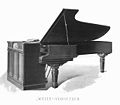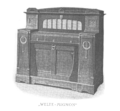Category:Welte-Mignon
Jump to navigation
Jump to search
reproducing keyboards brand (piano & pipe organ) of M. Welte & Shöne | |||||
| Upload media | |||||
| Instance of | |||||
|---|---|---|---|---|---|
| Discoverer or inventor | |||||
| Manufacturer | |||||
| Time of discovery or invention |
| ||||
| |||||
See also categories: M. Welte & Söhne and Welte-Mignon Corporation, New York.
References
[edit]- The world of the piano. Seewen SO: Museum für Musikautomaten." The Aeolian Company in the USA was first to launch an automated piano-playing system in the form of an external, 'push-up player': its Pianola appeared in 1897. The first European manufacturer to respond was the Ludwig Hupfeld Company in Leipzig, Germany, which launched its Phonola in the spring of 1902. Hupfeld introduced the use of music rolls recorded by performers in 1905. The company managed to capture the pianists' performances, complete with a range of interpretational characteristics, but was not able to master the dynamics of the performance. These had to be added by the operator during the playback. ",
" Edwin Welte and Karl Bockisch filed a patent for their Mignon reproducing process on 21 May 1904; it was first exhibited at the 1905 Leipzig Spring Fair. Welte went beyond the simple playback of a perforated music roll (which required a Pianola or Phonola operator to interact with the mechanism during the performance): he invented a system that permitted the authentic reproduction of performances by famous artists of the day. ",
" First off the Mignon production line was a keyboardless mechanism in cabinet-player form. In 1908 came an external 'push-up player' featuring the Mignon reproducing system, to be followed in 1909 by upright pianos incorporating the Mignon system and, in 1913, grand pianos. ",
" The Welte-Mignon system soon became the leading reproducing piano system in Germany and the USA. The Welte Company, however, began losing ground after the launch of the Aeolian Company's Duo-Art system and the Ampico piano, followed by the outbreak of the First World War. "
See also : Story of the Welte Company./ Orchestrions./ The Welte-Philharmonie organs.
Further reading
[edit](Note: underlined by editor)
- Klaus Fischer (circa 2017). M. Welte & Sons: Innovative - Authentic - Mysterious. Welte Mignon Authentisch (Welte-Mignon-Authentisch.de)." In 1904 ... M. Welte & Söhne in Freiburg im Breisgau made a sensational invention. They had developed a process that was able to record and reproduce "all the fine details of pianists" personal playing on paper rolls. / The reproduction mechanism bore the name "Welte Mignon". ",
" In 1905 the press celebrated the Welte-Mignon as the new world wonder after the first performances: ... ",
" Around 5,500 music titles were played for the Welte-Mignon. The last recordings of classical music took place in 1928 by Rudolf Serkin. ",
" The rapid spread of radio and record meant that Welte had to cease production of the reproducing instruments in 1932. ",
" Not a single one of the Mignon recording machines has survived. ... " - The History of M. Welte & Sons, Freiburg and New York (wiki). (welte-mignon.de)." The business complex in Freiburg was bombed and completely destroyed in November 1944. This event seemed to obscure the closely kept secret of the firm and the recording apparatus and recording process appeared lost forever. But in recent years parts of the recording apparatus for the Welte Philharmonie organs and documents were found in the United States. It was then possible to reconstruct the recording process at last theoretically. In the Augustinermuseum the inheritance of the firm is preserved - all that survived the Second World War. "Note: source is unclear!
Subcategories
This category has the following 8 subcategories, out of 8 total.
Media in category "Welte-Mignon"
The following 29 files are in this category, out of 29 total.
-
"The Japanese Sandman", Fox-Trot played by John Milton Delcamp (1920).oga 2 min 57 s; 1.73 MB
-
21 Programm Baden-Baden 1927.jpg 2,480 × 3,508; 931 KB
-
Brahms nikisch hd5.ogg 2 min 55 s; 2.98 MB
-
Brahms nikisch hd6.ogg 2 min 19 s; 2.37 MB
-
Chopin - Mazurka D major Op.33 no. 2 (or 3) played by Lubka Kolessa.oga 3 min 35 s; 3.54 MB
-
Emilvonsauer1905.jpg 2,478 × 1,641; 368 KB
-
Essipoffkl.jpg 2,059 × 1,789; 806 KB
-
Gabrilobrahms119 4.ogg 1 min 31 s; 1.56 MB
-
Graham at the piano, Siegfrieds Mechanisches Musikkabinett, Rüdesheim.jpg 4,000 × 3,000; 2.95 MB
-
IB Welte.jpg 1,024 × 768; 119 KB
-
Koczalski.jpg 732 × 591; 53 KB
-
Leoncavallo recording 1905.jpg 2,430 × 1,641; 1.58 MB
-
Nikisch19021906.jpg 2,478 × 1,584; 360 KB
-
Piano Welte Mignon-Maison de la musique mécanique (détail).jpg 5,472 × 3,648; 3.1 MB
-
Piano Welte Mignon-Maison de la musique mécanique.jpg 4,300 × 3,523; 2.38 MB
-
Pianolakontrolle.jpg 1,953 × 795; 638 KB
-
Skrjabin op 40 2.ogg 49 s; 677 KB
-
Trackerbar.jpg 2,727 × 1,896; 637 KB
-
UVM IraAllenOrgan 19270114.jpg 2,221 × 1,727; 2.22 MB
-
VorsetzerWelteMignon.jpg 1,240 × 1,084; 281 KB
-
Welte-Mignon Kabinett.jpg 2,048 × 1,536; 283 KB
-
WelteHandnuancierung.jpg 1,470 × 1,964; 271 KB
-
WelteMignon pipeorgan opus231 stops.jpg 323 × 1,000; 32 KB
-
WelteMignon pipeorgan opus231.jpg 450 × 302; 27 KB
-
WelteMignonKabinett.PNG 1,222 × 1,126; 633 KB
-
Welteorgel.jpg 4,000 × 3,000; 2.75 MB
-
Weltereproduktionsklavier.jpg 1,090 × 1,394; 292 KB
-
Weltesonspoughkeepsie.png 1,417 × 1,048; 680 KB
-
ザウアー1905.jpg 2,478 × 1,641; 956 KB




















